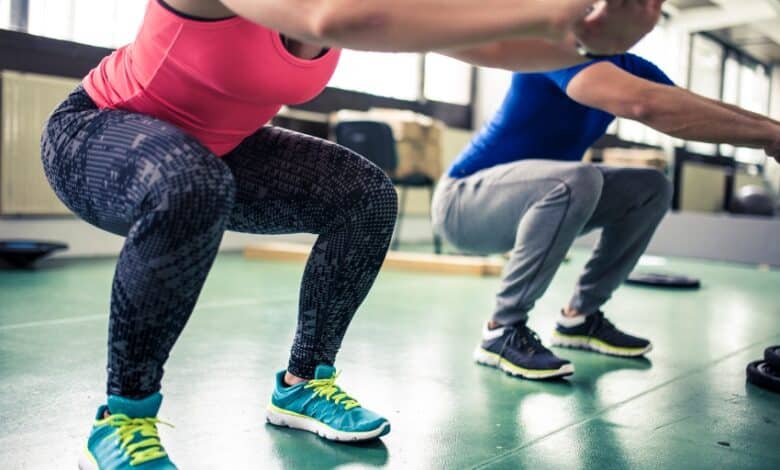Isometric Squat: The Best Exercise at Home to Strengthen Legs and Prevent Injuries

La isometric squat It is a simple exercise that strengthens the leg muscles and contributes to the prevention of joint injuries.
As well helps tone the Core area and reduces the percentage of fat. Learn here the correct technique to perform it and how to incorporate it into your training routine at home.
Isometric Squat Benefits
The isometric squat is an exercise effective for strengthening muscles and preventing injuries in different areas of the body. In addition, it has extensive benefits on a physical level that make it one of the best exercises that can be done at home.
Here are the main benefits of incorporating isometric squats into your training routine:
Muscle strengthening of legs and lower body
Isometric squats are an excellent exercise for strengthen the muscles of the legs and the lower body.
The load these muscles bear during exercise stimulates their growth, which translates into increased strength and physical endurance.
In addition, the isometric squat can help improve posture, reduce the risk of injury, and improve joint mobility in the area.
Prevention of injuries and osteoporosis
The isometric squat is a safe and effective exercise to prevent injuries to different parts of the body, including the knees, hips and spine.
In addition, it strengthens the bones and can help prevent osteoporosis in older people or those with a predisposition to this condition.
Toning and gaining strength in the Core
The Core is the central area of the body that includes the abdominal, lumbar and hip muscles.
Isometric squat exercises strengthen the Core, which translates into improved posture, muscle stability, and endurance capacity, even in the face of great physical efforts.
In addition, the correct technique of the isometric squat includes the activation of the Core, which contributes to its strengthening in an effective way.
Reduction of fat percentage and blood pressure
Isometric squats are a excellent exercise to reduce the percentage of body fat and blood pressure in sedentary people or with metabolic problems.
Physical activity stimulates metabolism and helps burn calories, which reduces accumulated fat in the body. In addition, increasing regular physical activity improves blood circulation and lowers blood pressure in sedentary people or with cardiovascular problems.
How to do the isometric squat correctly
The isometric squat is a great do-it-yourself exercise that strengthens your legs and lower body. without generating too much impact.
However, to optimize results and avoid injury, it is important to follow the correct technique. Here are some tips for doing the isometric squat correctly.
Correct technique to avoid injury
Before beginning the isometric squat, it is important to ensure that the following techniques are followed to avoid injury:
- Keep feet pointing forward and shoulder width apart
- Make sure you keep your shoulders and back straight and upright
- Do not arch your back, keep it in a neutral position throughout the movement
- Make sure your knees don't roll forward, they have to be "in line" with your ankles
- Press your heels into the ground to avoid knee injuries
Isometric squat variants
There are other variations of the isometric squat that can help improve your results, such as:
- Isometric Single Leg Support Squats, also known as Lunge Squats
- Isometric One-Legged Bent Half Squat, similar to an isometric double-legged bent squat, but with one leg more bent than the other
- Variations of the isometric squat with elastic bands.
Complementary exercises to improve technique
Here are some complementary exercises that can help improve isometric squat technique:
- Static stretching exercises before starting isometric squats to warm up the muscles and prevent injury
- Strength exercises with dynamic squats to improve technique and strengthen muscles
- Balance exercises such as the front plank, which help improve body stability during the isometric squat
The isometric squat can be a great addition to any training routine to improve strength and muscle development, as long as it is done correctly. Use these techniques and variations to get the best results and avoid any injury.
Isometric squat routine to do at home
The isometric squat is a very beneficial exercise to strengthen the body in general. Here's an isometric squat routine to do at home with a wall for support.
Effective Training with a Wall as Support
The isometric squat is a muscle-strengthening exercise that can be performed with the help of a wall for support.
Place your back against the wall and your feet hip-width apart.
Lower your body until your knees form a 90 degree angle.
Hold the position for 30-60 seconds and repeat several times.
Exercises and Recommendations to Make It More Effective
To make the isometric squat most effective, you must maintain good posture and engage in adequate muscle contraction.
Also, it is important to hold your breath and not hold your breath while holding the position.
You can also complement the isometric squat with other muscle-strengthening exercises to improve results.
Additional Muscle Strengthening Exercises
- Squat with jump
- Jumping jacks
- chest push-ups
- Abdominal planks
Additional Tips
- Start with a limited time and increase the time as you get used to the exercise.
- Avoid doing the deep position if you are a beginner.
- You must be careful with knee and spine pain.
- Warming up beforehand is essential to avoid injuries.
Isometric Squat Challenge to Improve Balance
The isometric squat can also be used to improve balance and coordination.
To do this, you can try performing the position on one leg or alternating legs in the air during the exercise. Also, you can add weights to increase the intensity of the exercise.
With this isometric squat routine to do at home you can get great benefits for your body. Remember to consult a professional before including this exercise in your training routine and do not force your body beyond its capabilities.
Duration and frequency for best results
To obtain the best results with the isometric squat it is important to establish an adequate frequency and an effective duration.
It is recommended to perform this exercise regularly at least 3 times a week to improve strength and muscle tone.
Regarding the duration, it is recommended that beginners start with short series of 15 to 20 seconds, and that they increase the time as they gain strength and resistance.
As you feel more comfortable with the exercise, you can increase the time of each series until you reach 30 or 60 seconds.
It is important to remember that the duration of the isometric squat should not exceed 60 seconds, as this can increase the risk of injury.
How to hold a proper weight
When doing the isometric squat, it is important that you choose an appropriate weight to avoid injuries. The ideal is to start without weight, simply with the resistance offered by your own body.
As you gain strength and endurance, you can add weight in the form of plates or dumbbells. Remember that it is not recommended to lift too much weight, as this can compromise technique and increase the risk of injury.
How to include the isometric squat in the overall training routine
The isometric squat is an effective leg and core strengthening exercise, but it's also important to include other exercises in your overall training routine to improve your overall health and well-being.
You can combine the isometric squat with other strength and cardiovascular exercises for the best results.
For example, you can do dynamic squats, lunges, jumping jacks, or running on the treadmill to work different muscle groups and improve your cardiovascular endurance.
It is important that you consult with a training professional to help you design an effective and safe training routine.
Additional exercises to complement the isometric squat training
The isometric squat is a complete exercise that helps you strengthen the muscles of the legs, the Core, and the hip and knee joints.
The following section includes additional exercises that will help you complement your training with the isometric squat, to improve not only your strength and fitness, but also your ability to perform other physical activities.
Plank exercises and complementary arms
Plank exercises are an excellent option to work the abdominal Core, which is located in the center of your body and is essential for balanced and stable movements.
Here are some plank exercises that you can integrate into your isometric squat training routine:
- Front plate: Rest your forearms and toes on the floor, keeping your body straight and without lifting your buttocks. Hold the pose for 15 seconds and perform 2-3 repetitions.
- Side plank: Rest one forearm and the outer edge of one foot on the floor, keeping your body straight and without lifting your buttocks. Hold the pose for 15 seconds and perform 2-3 repetitions on each side.
- Plank balanced on a ball: Place your forearms on a stability ball (like a Swiss ball), keeping your body straight and without lifting your buttocks. Hold the pose for 15 seconds and perform 2-3 repetitions.
In addition to plank exercises, you can also work your arms with specific exercises, such as push-ups or dumbbell bicep curls.
These exercises not only improve arm strength, but also help strengthen the muscles of the back and chest.
Strengthening of the abdominal Core and back
To complete your training with the isometric squat, it is important to also work the core abdominal and back muscles.
With these exercises, you will achieve greater stability and strength in the spine, which will allow you to perform movements in other physical activities more easily.
- Isometric plank: Rest your forearms and toes on the floor, keeping your body straight and without lifting your buttocks. Hold the pose for 30 seconds and perform 2-3 repetitions.
- Leg lift: Lie on your back with your legs straight and raise your legs as if you wanted to touch the ceiling with your feet. Do 2-3 sets of 10-15 repetitions.
- Abdominal Superman: Lie on your stomach with your arms and legs stretched out. Raise your arms and legs at the same time, holding the pose for 3-5 seconds. Do 2-3 sets of 10-15 repetitions.
Remember that these additional exercises are an excellent way to complement your training with the isometric squat, while improving your physical condition in a comprehensive and efficient way.
There are no previous results.




























